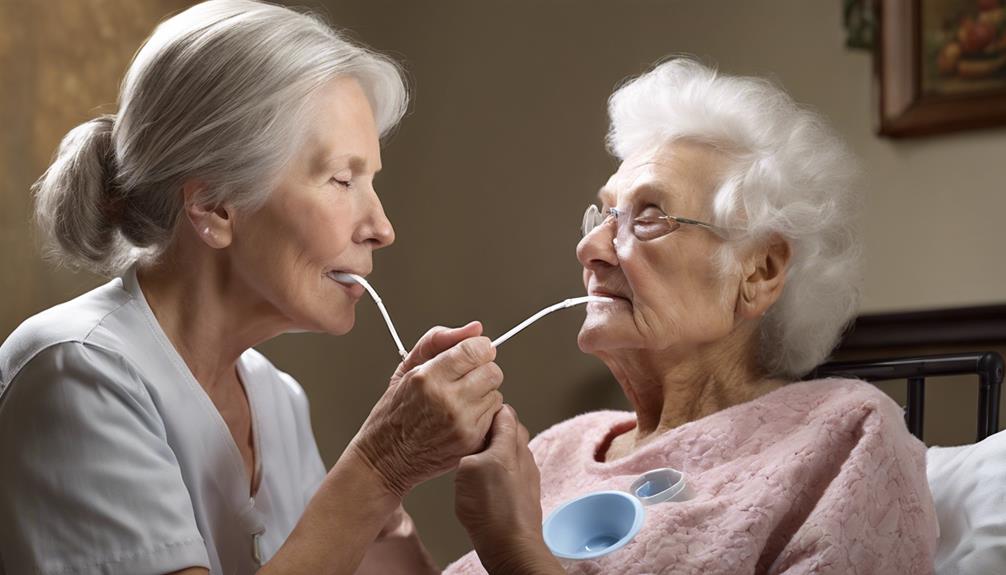Feeding tubes have advantages and disadvantages in elderly care. They can help prevent malnutrition, manage chronic conditions, and make caregiver duties easier. However, they may cause gastrointestinal problems, create nutritional deficiencies, and impact independence and overall health. It’s important to think about quality of life, the risk of aspiration pneumonia, and the individual’s preferences. For patients with dementia, hand feeding is often the preferred option. Ethical decisions should weigh the benefits and risks, with a focus on maintaining dignity and well-being. Exploring alternatives such as adjusting diets and closely monitoring complications is recommended. Understanding the significant long-term outcomes is crucial for making informed decisions about elderly care. Deeper insights are still needed into the complex considerations surrounding feeding tubes in this context.
Key Takeaways
- Prevents malnutrition and weight loss in elderly with swallowing difficulties.
- Increases risk of gastrointestinal complications and nutritional deficiencies.
- Impact on autonomy and emotional well-being must be considered.
- Regular monitoring and adjustments are essential for optimal care.
- Individual preferences and quality of life should guide decision-making.
Definition of Feeding Tubes
Feeding tubes, commonly referred to as NG tubes, serve as an essential means of providing liquid nutrition to individuals facing swallowing difficulties. NG tubes are inserted through the nose and reach the stomach, offering short-term nutrition support to those in need.
On the other hand, G tubes are inserted directly into the stomach, providing long-term nutrition solutions for individuals with prolonged swallowing issues. These tubes play an important role in ensuring that individuals receive the necessary nutrients when they're unable to consume food orally.
When individuals face challenges with swallowing, whether due to medical conditions or other factors, feeding tubes become a key tool in maintaining proper nutrition and hydration. Understanding the different types of tubes available, such as NG tubes for short-term support and G tubes for long-term care, allows healthcare providers to determine the most suitable option for each individual's specific needs.
Advantages of Tube Feeding

Tube feeding offers several advantages for elderly individuals, including improved nutrition intake, simplified meal preparation, and enhanced hydration management. These benefits can help maintain overall health and well-being by ensuring that essential nutrients are delivered effectively.
Additionally, tube feeding can provide crucial support for individuals with swallowing difficulties or those who require assistance with eating.
Improved Nutrition Intake
Ensuring elderly individuals receive adequate nutrition intake, tube feeding plays a pivotal role in preventing malnutrition and weight loss, supporting overall health and well-being in older adults.
Tube feeding offers several benefits:
- Preventing Malnutrition: Tube feeding provides essential nutrients, helping seniors stay nourished even when they can't consume food orally.
- Managing Chronic Conditions: It aids in managing chronic conditions by delivering necessary nutrients and hydration to support the body's healing processes.
- Enhancing Medical Care: Tube feeding allows seamless administration of medications and fluids, improving the overall medical care for elderly patients.
- Improving Quality of Life: Better nutrition intake through tube feeding can lead to improved health outcomes, enhancing the quality of life for the elderly population.
Simplified Meal Preparation
With tube feeding simplifying meal preparation, caregivers can now focus more on quality companionship with the elderly, ensuring a structured feeding schedule for best health outcomes. Tube feeding eliminates the need for complex meal preparation, making it easier for caregivers to provide nutrition to the elderly. This simplified approach reduces the time and effort required, allowing caregivers to spend more quality time with their loved ones.
Enhanced Hydration Management
Enhancing hydration levels in elderly individuals can be effectively managed through the use of feeding tubes. Tube feeding guarantees elderly individuals receive sufficient hydration, preventing dehydration complications like urinary tract infections or kidney issues.
Improved hydration management with feeding tubes can lead to better overall health and well-being for seniors facing hydration challenges. It provides a controlled and consistent method of delivering essential fluids to meet their hydration needs.
Adequate hydration through feeding tubes supports proper organ function and contributes to enhanced health outcomes in elderly care.
Disadvantages of Tube Feeding

Tube feeding serves a crucial purpose but can bring about challenges for elderly patients. These challenges include discomfort, potential infections, and the risk of complications due to tube placement. It's important to closely monitor and address these issues to guarantee the well-being of individuals relying on tube feeding for nutrition.
Having a structured approach to managing these challenges can help healthcare providers ensure the safety and effectiveness of tube feeding for elderly patients. This may involve regular assessments, communication with the healthcare team, and adjustments to the feeding regimen as needed. Such proactive measures can contribute to a better quality of life for patients who require tube feeding as part of their care.
Digestive System Impact
Tube feeding in elderly individuals can lead to various gastrointestinal complications, such as diarrhea, constipation, and bloating. These issues can arise due to age-related factors and the impact of tube feeding on the digestive system. Some disadvantages of tube feeding related to the digestive system include:
- Diarrhea: Excessive fluid intake can result in loose stools.
- Constipation: Lack of fiber in liquid diets can lead to difficulty in passing stools.
- Bloating: Accumulation of gas in the digestive tract may cause discomfort.
- Stomach Shrinkage: Long-term tube feeding can cause the stomach to decrease in size, affecting digestion.
It is crucial to monitor and address these challenges to safeguard the well-being of elderly individuals relying on tube feeding.
Nutritional Deficiencies
When considering tube feeding in elderly individuals, it's important to recognize that nutritional deficiencies can arise due to inadequate nutrient absorption, potentially leading to health complications. Elderly patients on tube feeding may experience electrolyte imbalances, affecting their overall well-being.
Additionally, the limited variety in tube feeding formulas could result in micronutrient deficiencies over time, impacting their overall nutritional status. Insufficient fiber intake from tube feeding can also have adverse effects on gut health and regularity.
Monitoring for signs of malnutrition in elderly patients on tube feeding is vital to address deficiencies promptly and meet their nutritional needs adequately. It's crucial to work closely with healthcare providers to tailor feeding regimens to individual needs and prevent these complications.
Impact on Quality of Life

Considering the introduction of feeding tubes for elderly care, the impact on quality of life encompasses various significant factors that require thoughtful evaluation. When evaluating the use of feeding tubes in elderly individuals with advanced dementia or swallowing difficulties, several key points come into play:
- Autonomy: The decision to use feeding tubes can affect one's sense of independence and control over their own body.
- Emotional Well-being: The presence of a feeding tube may influence the individual's emotional state and perception of their quality of life.
- Life Expectancy: Understanding how the use of feeding tubes may impact life expectancy is essential for making informed decisions.
- Financial Implications: The cost of long-term care, including the insertion and maintenance of feeding tubes, can have significant financial implications for families and caregivers.
These factors highlight the importance of considering not only the physical benefits but also the holistic impact on the individual's overall well-being when contemplating the use of feeding tubes in elderly care.
Risks of Aspiration Pneumonia

Aspiration pneumonia, a serious risk of feeding tubes in the elderly, occurs when food or liquid enters the lungs instead of the stomach, leading to infections.
This complication is particularly vital for frail individuals and can be life-threatening.
Proper placement and monitoring of feeding tubes are essential in preventing aspiration pneumonia and maintaining the health of elderly patients.
Aspiration Pneumonia Prevention
Regularly monitoring elderly individuals with dysphagia for signs of aspiration pneumonia is crucial in preventing serious complications.
To help prevent aspiration pneumonia in elderly care, consider the following measures:
- Ensure proper placement of feeding tubes to direct food into the stomach.
- Monitor elderly individuals with dysphagia closely for any signs of respiratory distress.
- Provide adequate training to caregivers on the management of feeding tubes.
- Seek prompt medical attention if any symptoms of aspiration pneumonia, such as coughing during meals, are observed.
These steps can substantially reduce the risk of aspiration pneumonia and its associated complications in elderly individuals with swallowing difficulties.
Complications of Aspiration
Understanding the potential complications of aspiration, particularly the risks associated with aspiration pneumonia, is essential in providing effective care for individuals with dysphagia. Aspiration pneumonia poses a significant threat to the elderly, especially those with swallowing difficulties. When food or liquid enters the airways instead of the stomach, it can lead to serious respiratory issues and even prove fatal, particularly for older adults with advanced dementia.
Preventing aspiration through proper feeding techniques is vital in reducing the risk of pneumonia and related health problems. By being mindful of the risks associated with aspiration pneumonia, caregivers can tailor feeding methods to secure the well-being and overall health of elderly individuals with dysphagia.
Considerations for Dementia Patients

When looking after elderly individuals with dementia, it’s crucial to take into account their specific needs and challenges related to feeding and nutrition. Advanced dementia can lead to dysphagia, causing difficulties with eating, swallowing, and recognizing food. It is essential to provide meals that are not only nutritious but also easy to consume, often requiring modifications to texture and consistency. Caregivers should remain vigilant about the dehydration and appetite loss connection, as the inability to recognize thirst or hunger can further complicate their nutritional intake. By closely monitoring fluid and food consumption, caregivers can help mitigate these risks and support the overall health and well-being of individuals with dementia.
Here are some considerations for dementia patients:
- Hand Feeding: Hand feeding is often preferred over tube feeding for advanced dementia patients.
- PEG Tubes: Percutaneous gastrostomy tubes (PEG tubes) are commonly used for feeding older adults with advanced dementia by providing food, water, and medication.
- Aspiration Risks: Dysphagia in older adults with advanced dementia increases the risk of weight loss, dehydration, and dangerous aspiration pneumonia.
- Limited Benefits: Studies indicate limited benefits and potential harm from using feeding tubes in dementia patients, with no reduction in aspiration pneumonia risk.
Ethical Concerns and Decision Making

Ethical considerations surrounding the use of feeding tubes for elderly individuals require a delicate balance between potential benefits and associated risks. When making decisions about artificial nutrition and hydration, it's essential to take into account ethical concerns, individual preferences, and the quality of life of the elderly person. Advance directives, such as living wills, are indispensable in guiding these decisions and ensuring they align with the wishes of the individual. Healthcare providers play an indispensable role in discussing the benefits and burdens of feeding tubes, helping families make informed choices.
When faced with the decision of whether to use a feeding tube for an elderly loved one, it's crucial to contemplate not only the medical aspects but also the ethical implications. By carefully weighing the options and consulting with healthcare professionals, families can make decisions that uphold the dignity and well-being of their loved ones. Remember, the goal is always to provide the best possible care while respecting the individual's wishes and values.
Alternatives to Feeding Tubes

To explore effective caregiving options beyond feeding tubes, considering alternative feeding methods for elderly individuals with swallowing challenges is essential. When faced with difficulties in swallowing, there are several alternatives to feeding tubes that can be beneficial for elderly care:
- Hand feeding: Providing meals by hand can offer a more personalized and comforting approach to feeding elderly individuals.
- Thickening liquids: Adjusting the consistency of liquids can help prevent aspiration and make swallowing easier for seniors.
- Swallowing exercises: Engaging in speech therapy and specific exercises can strengthen swallowing muscles and improve overall swallowing function.
- Consulting with a dietitian or nutritionist: Seeking guidance from professionals can lead to personalized dietary plans that cater to the unique needs of elderly individuals, ensuring they receive adequate nutrition without the use of feeding tubes.
These alternatives focus on maintaining dignity, improving quality of life, and addressing swallowing challenges in a compassionate and effective manner.
Monitoring and Care Management

Regular monitoring is vital for ensuring the best care and maintenance of feeding tubes in elderly individuals. Proper tube care involves checking for signs of infection, displacement, or complications to address issues promptly. Adequate flushing and maintenance help prevent blockages and infections, guaranteeing the smooth functioning of the feeding tube. Adjusting feeding schedules and formulas based on individual needs guarantees proper nutrition and hydration for elderly patients relying on feeding tubes. Emotional support during the tube feeding process is essential, enhancing the overall well-being and quality of life for elderly individuals.
| Monitoring and Care Management | Benefits |
|---|---|
| Regular monitoring for signs of complications | Early detection and intervention |
| Proper tube care and maintenance | Prevention of blockages and infections |
| Adjusting feeding schedules based on individual needs | Ensuring proper nutrition and hydration |
| Providing emotional support during tube feeding | Enhancing overall well-being |
Effective care management involves collaboration between healthcare providers, caregivers, and family members to ensure the best outcomes for elderly patients. This teamwork ensures that the elderly receive all-encompassing care and support tailored to their specific needs.
Long-Term Outcomes and Effectiveness

As we contemplate the long-term outcomes and effectiveness of feeding tubes for elderly care, it becomes evident that studies raise questions regarding the significant improvement in nutritional status or quality of life for this population. While the decision to opt for a feeding tube should be individualized, here are some important points to ponder:
- Nutritional Status: Studies suggest that the use of feeding tubes in the elderly may not always lead to a significant improvement in their nutritional status.
- Quality of Life: The effectiveness of feeding tubes in enhancing the quality of life for elderly individuals remains debatable.
- Complications: Long-term use of feeding tubes can sometimes result in complications such as infections and issues related to the tube itself.
- Advanced Dementia: Research indicates that elderly individuals with advanced dementia may not experience substantial benefits from long-term feeding tube placement.
Understanding these factors is vital when making decisions about the use of feeding tubes for elderly care, ensuring that the best possible outcomes are achieved.
Frequently Asked Questions
What Are the Downsides of a Feeding Tube?
We must consider the downsides of feeding tubes, such as potential choking, discomfort, pneumonia risks, erosions in nasal passages, and infections. Patients may try to remove tubes, needing restraints and facing injuries, while tubes can get blocked, dislodged, and cause ulcers.
What Are the Problems With Feeding Tubes in the Elderly?
Feeding tubes in the elderly can lead to various complications like infections, discomfort, and injuries. They may cause erosions and abrasions in nasal passages, posing risks. Problems include blockages, dislodgment, and infections, impacting elderly care.
When Is a Feeding Tube Not a Good Idea?
When a feeding tube is not a good idea, we consider the risks and benefits carefully. Factors like quality of life, patient preferences, and potential complications guide our decisions. We prioritize informed choices and holistic care.
Why Are People Against Feeding Tubes?
We avoid feeding tubes due to risks like infections, choking, discomfort, and injuries. Tubes can lead to erosions in nasal passages, stomach, and esophagus. Patients may try to remove them, requiring restraints.
Conclusion
To sum up, while feeding tubes can provide necessary nutrition for elderly individuals, it's vital to ponder both the benefits and drawbacks.
It's essential to assess the impact on quality of life, potential risks such as aspiration pneumonia, and ethical concerns when making decisions about tube feeding.
Alternatives should be explored, and careful monitoring and care management are indispensable for long-term outcomes. In particular, the benefits of assisted living can provide a supportive and structured environment for individuals who may struggle with daily tasks or have complex healthcare needs. This option ensures that residents receive the appropriate level of care while also promoting autonomy and independence where possible. Ultimately, a tailored plan that incorporates both alternative approaches and ongoing oversight is essential for optimizing quality of life.
Ultimately, the choice of feeding tube use should be made thoughtfully and with the individual's best interests in mind.









